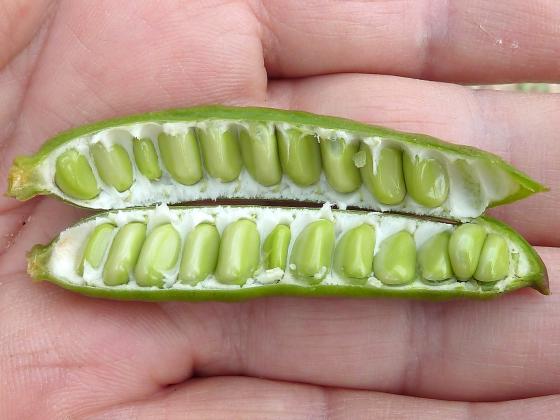Vachellia farnesiana – Perfume, medicine, fixes pottery
Vachellia farnesiana, synonym Acacia farnesiana, has common names of sweet acacia, needle bush and huisache (pronounced wee-satch). Native to the southern U.S. and Central America, it’s a perennial bushy, thorny shrub or small tree. It’s a legume, in the bean family, with leaves alternate and bipinnately arranged. Seedpods resemble fat green beans. Huisache has puffy yellow to yellow-orange fragrant flowers which are on the tree before the leaves making it stand out in the landscape. Some of the most expensive perfumes are based on an essence called cassie extracted from huisache flowers.
The word huisache is from an Aztec word meaning “many thorns”. The plant has sharp needle-like 2 inch thorns that are hard and sharp enough to puncture tractor tires. It spreads readily and is difficult to remove. An understatement is that farmers and ranchers do not like huisache.
A honey-colored resin or gum is exuded from the wood and roots. It’s similar to gum arabic and for some applications, some say it is better. Gum arabic, primarily harvested from Acacia spp., has many uses in many industries. It is a lickable glue for stamps, envelopes and cigarette papers. It’s a binder in paints, drugs, cosmetics, etc. It’s in frosting, soft drinks, chewing gum, candy, etc.
Since ancient times gum arabic has been used in ceramic glazes and huisache gum can be used the same way. Broken pottery can be fixed with its gum. Huisache bark is used for ink, tanning and dying leather, etc.
Huisache is astringent. Traditional medicine systems of Texas and Central America have used it medicinally to treat diarrhea, malaria, etc. For skin conditions and wounds, it is powdered and rubbed on the skin. Ashes from the burned plant are used the same way. Boiled roots are used as a wash to treat pink eye and in a bath for other conditions. Roots are chewed for sore throat. A plaster for sore joints is made from the pulp.
The National Institutes of Health has articles about the plant at ncbi.nlm.nih.gov. The article “The Medicinal Plants of Myanmar” mentions that water from boiled roots is used as a mouthwash, for toothaches, inflammation, infections, bleeding of the gums, etc. It says that a paste of the plant is put on the hooves of cattle to kill or prevent parasites. The article uses the synonym A. farnesiana. Under the same synonym, the plant is in the Food and Drug Administration Poisonous Plant Database at fda.gov.
Deer, livestock and other mammals eat the leaves and seedpods, spreading the seeds. Bees, hummingbirds, moths and other insects eat the flower’s nectar. Birds and small animals use huisache for nesting and cover.
Those that cut down huisache should note that its wood is sought after by woodworkers because of its beautiful grain pattern, orange-red color and other properties. The tree is often removed before it’s fully grown so it’s difficult for them to find large pieces. Even small pieces are purchased to make cutting boards, eating utensils and other small objects.
Deborah Richardson is a freelance reporter for The Examiner with a fondness for flora in its natural setting.


